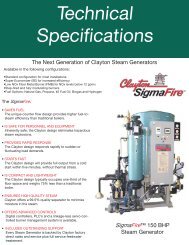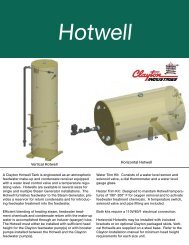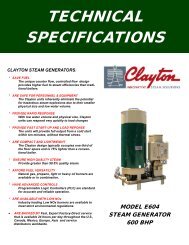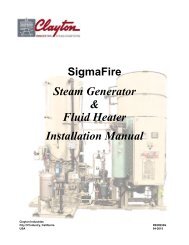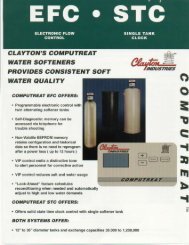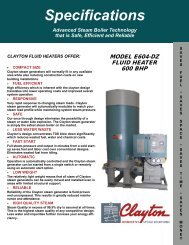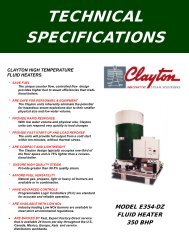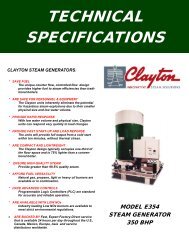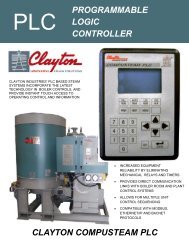Steam Generator Installation Manual - Clayton Industries
Steam Generator Installation Manual - Clayton Industries
Steam Generator Installation Manual - Clayton Industries
You also want an ePaper? Increase the reach of your titles
YUMPU automatically turns print PDFs into web optimized ePapers that Google loves.
<strong>Steam</strong> <strong>Generator</strong> & Fluid Heater<br />
<strong>Installation</strong> <strong>Manual</strong><br />
2.5.1 Installing Exhaust Stacks<br />
<strong>Clayton</strong> strongly recommends a barometric damper on all installations. Proper installation of<br />
the exhaust stack is essential to the proper operation of the <strong>Clayton</strong> steam generator. <strong>Clayton</strong> specified<br />
allowable back-pressure of 0.0 to -0.25 w.c.i. must be considered when designing and installing the exhaust<br />
stack. The stack installer is responsible for conforming to the stack draft back-pressure requirements.<br />
Ninety-degree elbows should be avoided. Forty-five degree elbows should be used when the stack cannot be<br />
extended straight up. Stacks in excess of 20 feet (6 meter) may require a barometric damper. Stacks for all<br />
low NOx generators require a barometric damper.<br />
The material and thickness of the exhaust stack must comply with local code requirements, and be<br />
determined based on environmental and operating conditions (exposure to the elements, humidity, constituents<br />
of fuel, etc.). The area of free air space between the exhaust stack and building, roof, or flashings must<br />
also comply with local codes. The material used for roof flashings must be rated at a minimum of 600 o F<br />
(315 o C). A “weather cap” must be installed on top of the exhaust stack.<br />
IMPORTANT<br />
The specified exhaust stack connection size (shown in Tables 6-2 through 6-5, in<br />
Section VI, and in <strong>Clayton</strong>’s Plan <strong>Installation</strong> Drawings) is the minimum required for<br />
<strong>Clayton</strong>’s equipment. It is NOT indicative of the required stack size to meet installation<br />
requirements or by local codes. All exhaust stack installations must be sized to<br />
meet prevailing codes, company and agency standards, and local conditions, as well<br />
as, the recommended requirements specified above.<br />
NOTE<br />
<strong>Clayton</strong> recommends all generators purchased with our integral economizers be installed<br />
with stainless steel, insulated, double-walled exhaust stacks. All units operating<br />
on light or heavy oil should use stacks constructed with stainless steel. <strong>Clayton</strong><br />
recommends all heavy oil units use a free-standing, vertical stack, with clean-out access,<br />
as shown in Figure 2-4<br />
NOTE<br />
All oil-fired units must have an exhaust gas temperature indicator installed in the<br />
stack.<br />
A removable spool piece must be installed at the generator flue outlet to facilitate removal and<br />
inspection of the heating coil. To permit sufficient vertical lift, the spool piece should be at least 4 feet<br />
(1.2 m) tall. The spool installation should be coordinated with the customer supplied rigging. If operating on<br />
any type of fuel oil, an access door must be provided immediately at the generator flue outlet (first vertical<br />
section) to provide a means for periodic water washing of the heating coil. The section of the stack located<br />
inside the building should be insulated to reduce heat radiation and noise.<br />
Sect02_Genrl-xx4_s.fm 2-6 04/21/2015



